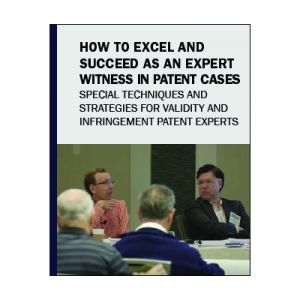Excerpted from SEAK’s Course: How to Excel as an Expert Witness in Patent Cases: Special Techniques
Now there’s a doctrine of equivalents and this is something we’re experts are called upon quite a bit and this is a really tricky area of the law. So it’s doctrine of equivalents or DOE as we like to abbreviate everything. So even if you can’t prove that every element is in the prior art. Let’s say, so this is such a simple one tried to do. Let’s say the seat was here and there’s something else. Let’s say…we’re gonna get complex. Let’s say our claim constructions would construe seat to mean a flat surface that receives, you know, a butt essentially or something like. So our understanding of seat is that this flat surface, but let’s say they accused product is got a like a bean bag top or something like that so it’s not a flat surface, all right, and so then it doesn’t literally infringe. But the law recognizes back of a couple decades ago that that that kind of a literal refrigerant encourages accused infringes to make just small changes, and is it really fair that if they make the small change that they somehow avoided the claim? And so they came up with the doctrine of equivalents, it’s a judge-made doctrine. And it basically says, “If the differences between the accused product and the absent limitation are insubstantial,” so it’s the insubstantial differences. So if the difference between having a flat seat and one as a little bubble on it is insubstantial, you know in light of what the purpose of the seat is supporting human, then it might still infringe undo this doctrine of equivalents and you can tell right away this is…lawyers love this especially the plaintiff side because gives you a lot of wiggle room to say, “Oh, that’s not really substantial difference,” and so you have this big fight. And so they try to cabin it in, they have what’s called the function way result test. Does the accused product function in the same way as the claimed product? Does it perform the same function as the claim product? Does it do it in the same way and does it have the same result? And so that’s when you might have seen it some of the examples of doberting [SP] that were in the handbook, references to the function wave result their doctrine of equivalents because this is a common area where experts are asked at the last minute in your report will have, you know, spent weeks on it weeks on it, done literal infringement on it, then someone walks in and says, “Well what if they doing? What if they try to argue that that’s slightly different and so you’ll be asked to include a doctrine of equivalents analysis kind of at the end. This is a typical scenario from the ones that we saw in the handbook. And so what happens if you throw it in and if it doesn’t infringe literally at the doctrine of equivalence, kind of full stop. That the law would say in, “That’s insufficient you get doberted on that. And so that means that trial you can’t offer doctrine of equivalents opinion. If you want to have a DOE opinion, you need to walk through the whole function way result test and, you know, a lot of time it’s on the lawyers because the lawyers, we like to focus on literal infringement and it’s at the last minute that we get nervous and say, “What if we don’t have literal infringement?” We want to try to have as many arrows as we can going into trial. And so, we try to squeeze one in. So if you’re asked to do a doctrine of equivalents analysis, you need to try…recognize that it requires actual analysis. There is an entire test you have to walk through of the different function, the function way and result test, essentially.

